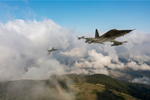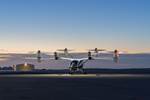BAE Systems composite mission workstation qualifies to serve aboard P-8A Poseidon
Maritime patrol and reconnaissance aircraft takes to the skies with the reliable mission computing technology which improves aircraft and weapon systems’ performance.
P-8A Poseidon is a variant of the Boeing 737-800. Photo Credit: BAE Systems
’ (Farnborough, U.K.) composite combat system mission crew workstation (CSMCW) is now qualified for the P-8A Poseidon multi-mission maritime patrol aircraft, adding to the aircraft’s mission capability. The qualification follows a successful test flight of the first combat system-capable P-8A test aircraft in June 2022.
The workstation is the aircrew’s primary interface to mission-critical systems, reportedly enabling them to successfully navigate demanding anti-submarine, anti-surface and intelligence, surveillance and reconnaissance missions. There are two systems per aircraft, which control the aircraft’s sonar, radar, sensors and weapon systems.
“Our mission computing and display system provides the reliability required for aircrews to operate in challenging environments,” Donna Linke-Klein, director of Tactical Systems at BAE Systems, says. “This newly qualified workstation will enable superior mission computing performance while providing size, weight, power and ergonomic benefits.”
Built with ultra-strong lightweight composite materials, the workstations improve aircraft and weapon systems’ performance, according to BAE Systems. They are also designed with ergonomic considerations, such as an optimal viewing angle for both seated and standing crewmembers.
With installation potential on approximately 130 aircraft for the U.S. Navy, and additional Foreign Military Sale opportunities, this qualification, completed at the BAE Systems’ Greenlawn, N.Y., U.S. site, also positions the workstations for mission enhancements on future aircraft.
BAE Systems has been designing and manufacturing cost-effective military computer and display systems for more than 50 years. The company says it provides state-of-the-art identification and mission computing products, leveraging commercial off-the-shelf hardware to develop modular, scalable and flexible systems that reduce development costs for new and emerging platforms.
Related Content
-
U.S. Navy contract to advance Cambium C/C composites for hypersonics
Cambium aims to further optimize its phthalonitrile-based thermal protection portfolio to create a secure domestic supply for U.S. hypersonics.
-
Carbeon C/C-SiC ceramic matrix composites without fiber coating
Dutch startup Arceon is working with leaders in space, hypersonics and industry to test its Carbeon CMC, validating near-net-shape parts with <3% porosity and performance at 1600ºC, targeting UHTCMC and a presence in the U.S. in 2025.
-
“Structured air” TPS safeguards composite structures
Powered by an 85% air/15% pure polyimide aerogel, Blueshift’s novel material system protects structures during transient thermal events from -200°C to beyond 2400°C for rockets, battery boxes and more.






